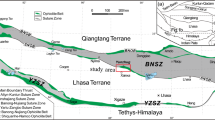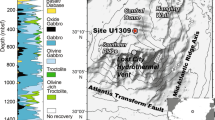Abstract
We determined the lithium isotope fractionation between synthetic Li-bearing serpentine phases lizardite, chrysotile, antigorite, and aqueous fluid in the P,T range 0.2–4.0 GPa, 200–500°C. For experiments in the systems lizardite-fluid and antigorite-fluid, 7Li preferentially partitioned into the fluid and Δ7Li values followed the T-dependent fractionation of Li-bearing mica-fluid (Wunder et al. 2007). By contrast, for chrysotile-fluid experiments, 7Li weakly partitioned into chrysotile. This contrasting behavior might be due to different Li environments in the three serpentine varieties: in lizardite and antigorite lithium is sixfold coordinated, whereas in chrysotile lithium is incorporated in two ways, octahedrally and as Li-bearing water cluster filling the nanotube cores. Low-temperature IR spectroscopic measurements of chrysotile showed significant amounts of water, whose freezing point was suppressed due to the Li contents and the confined geometry of the fluid within the tubes. The small inverse Li-isotopic fractionation for chrysotile-fluid results from intra-crystalline Li isotope fractionation of octahedral Li[6] with preference to 6Li and lithium within the channels (Li[Ch]) of chrysotile, favoring 7Li. The nanotubes of chrysotile possibly serve as important carrier of Li and perhaps also of other fluid-mobile elements in serpentinized oceanic crust. This might explain higher Li abundances for low-T chrysotile-bearing serpentinites relative to high-T serpentinites. Isotopically heavy Li-bearing fluids of chrysotile nanotubes could be released at relatively shallow depths during subduction, prior to complete chrysotile reactions to form antigorite. During further subduction, fluids produced during breakdown of serpentine phases will be depleted in 7Li. This behavior might explain some of the Li-isotopic heterogeneities observed for serpentinized peridotites.





Similar content being viewed by others
References
Agranier A, Lee CTA, Li ZXA, Leeman WP (2007) Fluid-mobile element budgets in serpentinized oceanic lithospheric mantle: insights from B, As, Li, Pb, PGEs and Os isotopes in the Feather River Ophiolite, California. Chem Geol 245:230–241
Auzende AL, Daniel I, Reynard B, Lemaire C, Guyot F (2004) High-pressure behaviour of serpentine minerals: a Raman spectroscopic study. Phys Chem Miner 31:269–277
Balan E, Mauri F, Lemaire C, Brouder C, Guyot F, Saitta AM, Devouard B (2002) Multiple ionic-plasmon resonances in naturally occurring multiwall nanotubes: infrared spectra of chrysotile asbestos. Phys Rev Lett 89:177401-1–177401-4
Barnes JD, Sharp ZD, Fischer TP (2008) Chlorine isotope variations across the Izu-Bonin-Mariana arc. Geology 36(11):883–886
Bates TF, Comer JJ (1959) Further observations on the morphology of chrysotile and halloysite. In: Proceedings of the 6th national conference on clay and clay minerals, pp 237–248
Benton LD, Ryan JG, Savov IP (2004) Lithium abundance and isotope systematics of forearc serpentinites, Conical Seamounts, Mariana forearc: insights into the mechanics of slab-mantle exchange during subduction. Geochem Geophys Geosyst 5:8. doi:10.1029/2004GC000708
Brearley AJ, Barnes JD, Sharp ZD (2007) Chrysotile nanotubes: potential host of insoluble chlorine in serpentinized oceanic crust. Abstracts of AGU Fall Meeting, #V11E-04
Bromiley GD, Pawley AR (2003) The stability of antigorite in the systems MgO–SiO2–H2O (MSH) and MgO–Al2O3–SiO2–H2O (MASH): the effect of Al3+ substitution on high-pressure stability. Am Mineral 88:99–108
Chan LH, Savov IP, Ryan JG (2006) Lithium isotope study of peridotite-slab fluid interactions in the Mariana mantle wedge. Abstracts of AGU Fall Meeting, #V43A-03
Decitre S, Deloule E, Reisberg L, James R, Agrinier P, Mével C (2002) Behavior of Li and its isotopes during serpentinization of oceanic peridotites. Geochem Geophys Geosyst 3:1. doi:10.1029/2001GC000178
Deschamps F, Guillot S, Godard M, Chauvel C, Andreani M, Hattori K (2009) In situ characterization of serpentinites from forearc mantle wedges: Timing of serpentinization and behaviour of fluid-mobile elements in subduction zones. Chem Geol (in press). doi:10.1016/j.chemgeo.2009.10.002
Dutrow BL (1991) The effects of Al and vacancies on Li substitution in iron staurolite: a synthesis approach. Am Mineral 76:42–48
Evans BW, Johannes W, Oterdoom H, Trommsdorff V (1976) Stability of chrysotile and antigorite in the serpentinite multisystem. Schweizer Mineral Petrogr Mitt 56:79–93
Foresti E, Hochella MF Jr, Kornishi H, Lesci IG, Madden AS, Roveri N, Xu H (2005) Morphological and chemical/physical characterization of Fe-doped synthetic chrysotile nanotubes. Adv Funct Mater 15:1009–1016
Grobéty BH, Métraux C, Ulmer P (2004) Chrysotile, a template for metal nanowires. Abstracts of 32nd International Geological Congress, p 308
Halama R, Savov IP, Rudnick RL, McDonough F (2009) Insights into Li and Li isotope cycling and sub-arc metasomatism from veined mantle xenoliths, Kamchatka. Contrib Mineral Petrol 158:197–222
Hattori KH, Guillot S (2003) Volcanic fronts as consequence of serpentine dehydration in mantle wedge. Geology 31:525–528
Hattori KH, Guillot S (2007) Geochemical character of serpentinites associated with high- to ultrahigh-pressure metamorphic rocks in the Alps, Cuba, and the Himalayas: recycling of elements in subduction zones. Geochem Geophys Geosyst 8:9. doi:10.1029/2007GC001594
Jahn S, Wunder B (2009) Lithium speciation in aqueous fluids at high P and T studied by ab initio molecular dynamics and consequences for Li-isotope fractionation between minerals and fluids. Geochim Cosmochim Acta 73:5428–5434
Kunze G (1961) Antigorit. Strukturtheoretische Grundlagen und ihre praktische Bedeutung für die weitere Serpentin-Forschung. Fortschr Mineral 39:206–324
Lemaire C, Guyot F, Reynard B (1999) Vibrational spectroscopy (IR and Raman) of OH groups in chrysotile, lizardite and antigorite. European Union of Geosciences 10, Journal of Conference Abstracts 4, p 654
Libowitzky E, Rossman GR (1997) An IR absorption calibration for water in minerals. Am Mineral 82:1111–1115
Lundstrom CC, Chaussidon M, Hsui AT, Keleman P, Zimmerman M (2005) Observations of Li isotopic variations in the trinity ophiolite: evidence for isotopic fractionation by diffusion during mantle melting. Geochim Cosmochim Acta 69:735–751
Marschall HR, Meyer C, Wunder B, Ludwig T, Heinrich W (2009) Experimental boron-isotope fractionation between tourmaline and fluid: confirmation from in situ analyses by secondary-ion mass spectroscopy and from Rayleigh fractionation modeling. Contrib Mineral Petrol 158:675–681
Maslennikova TP, Korytkova EN, Gusarov VV (2008) Interaction of Mg3Si2O5(OH)4 nanotubes with potassium hydroxide. Russ J Appl Chem 81(3):375–379
Mellini M (2005) Micro- and mesoporous carbon forms, chrysotile, and clathrates. In: Ferraris G, Merlino S (eds) Micro- and mesoporous mineral phases. Rev Mineral Geochem 57:435–448
Métraux C, Grobéty BH, Ulmer P (2002) Filling of chrysotile nanotubes with metals. J Mater Res 17:1129–1135
Mével C (2003) Serpentinization of abyssal peridotites at mid-ocean ridges. Comtes Rendus Geosci 335:825–852
Meyer C, Wunder B, Meixner A, Romer RL, Heinrich W (2008) Boron-isotope fractionation between tourmaline and fluid: an experimental re-investigation. Contrib Mineral Petrol 156:259–267
Moriguti T, Nakamura E (1998) Across-arc variation of Li isotopes in lavas and implications for crust/mantle recycling at subduction zones. Earth Planet Sci Lett 163:167–174
Richter FM, Davis AM, DePaolo DJ, Watson B (2003) Isotope fractionation by chemical diffusion between molten basalt and rhyolite. Geochim Cosmochim Acta 67:3905–3923
Rüpke LH, Morgan JP, Hort M, Connolly JAD (2004) Serpentine and the subduction water cycle. Earth Planet Sci Lett 223:17–34
Salje E, Carpenter MA, Malcherek T, Boffa-Bollaran T (2000) Autocorrelation analysis of infrared spectra from minerals. Eur J Mineral 12:503–519
Savov IP, Ryan JG, D’Antonio M, Kelley K, Mattie P (2005) Geochemistry of serpentinized peridotites from the Marina Forearc Conical Seamount, ODP Leg 125: Implications for the elemental recycling at subduction zones. Geochem Geophys Geosyst 6. doi:10.1029/2004GC000777
Scambelluri M, Müntener O, Ottolini L, Pettke TT, Vannucci R (2004) The fate of B, Cl and Li in the subducted oceanic mantle and in the antigorite breakdown fluids. Earth Planet Sci Lett 222:217–234
Schauble EA (2004) Applying stable isotope fractionation theory to new systems: In: Johnson CM, Beard BI, Albarede F (eds) Geochemistry of non-traditional stable isotopes. Rev Mineral Geochem 55:65–111
Seitz H-M, Woodland AB (2000) The distribution of lithium in peridotitic and pyroxenitic mantle lithologies—an indicator of magmatic and metasomatic processes. Chem Geol 166:47–64
Shannon RD (1976) Revised effective ionic radii and systematic studies of interatomic distances in halides and chalcogenides. Acta Crystallogr A 32:751–767
Staub SM, Layne GD (2002) The systematics of boron isotopes in Izu arc front volcanic rocks. Earth Planet Sci Lett 198:25–39
Takamuku T, Yamagami M, Wakita H, Masuda Y, Yamaguchi T (1997) Thermal property, structure, and dynamics of supercooled water in porous silica by calorimetry, neutron scattering, and NMR relaxation. J Phys Chem B 101:5730–5739
Tenthorey E, Hermann J (2004) Compositions of fluids during serpentinite breakdown in subduction zones: evidence for limited boron mobility. Geology 32(10):865–868
Tomascak PB (2004) Developments in the understanding and application of lithium isotopes in the earth and planetary sciences. In: Johnson CM, Beard BI, Albarede F (eds) Geochemistry of non-traditional stable isotopes. Rev Mineral Geochem 55:153–195
Ulmer P, Trommsdorff V (1995) Serpentine stability to mantle depths and subduction related magmatism. Science 268:858–861
Velde B (1980) Ordering of synthetic aluminous serpentinites; infrared spectra and cell dimensions. Phys Chem Miner 6:209–220
Vils F, Kalt A, Müntener O, Ludwig T (2009) Light elements in oceanic and ophiolitic serpentinites and implications for element recycling in subduction zones. Geochim Cosmochim Acta Suppl 73:A1386
Watenphul A, Wunder B (2009) Temperature dependence of the OH-stretching frequencies in topaz-OH. Phys Chem Miner (in press). doi:10.1007/s00269-009-0310-6
Wenger M, Armbruster T (1991) Crystal chemistry of lithium: oxygen coordination and bonding. Eur J Mineral 3:387–399
Williams LB, Hervig RL (2005) Lithium and boron isotopes in illite–smectite: the importance of crystal size. Geochim Cosmochim Acta 69:5705–5716
Wirth R (2004) Focused ion beam (FIB): a novel technology for advanced application of micro- and nanoanalysis in geosciences and applied mineralogy. Eur J Mineral 16:863–876
Wunder B, Schreyer W (1997) Antigorite: high-pressure stability in the system MgO–SiO2–H2O (MSH). Lithos 41:213–227
Wunder B, Wirth R, Gottschalk M (2001) Antigorite: pressure and temperature dependence of polysomatism and water content. Eur J Mineral 13:485–495
Wunder B, Meixner A, Romer RL, Heinrich W (2006) T-dependent isotopic fractionation of lithium between clinopyroxene and high-pressure hydrous fluids. Contrib Mineral Petrol 151:112–120
Wunder B, Meixner A, Romer RL, Feenstra A, Schettler G, Heinrich W (2007) Lithium isotope fractionation between Li-bearing staurolite, Li–mica and aqueous fluids: an experimental study. Chem Geol 238:277–290
Yamaji K, Makita Y, Watanabe H, Sonoda A, Kanoh H, Hirotsu T, Ooi K (2001) Theoretical estimation of lithium isotopic reduced partition function ratio of lithium ions in aqueous solution. J Phys Chem A 105:602–613
Yamasaki T, Seno T (2003) Double seismic zone and dehydration embrittlement of the subducting slab. J Geophys Res 108:B4. doi:10.1029/2002JB001918
Acknowledgments
The authors are grateful to G. Berger and A. Schreiber for sample preparation and to H.-P. Nabein for technical assistance in the hydrothermal laboratory. Thanks to M. Barth of the Max Planck Institute of Colloids and Interfaces, Potsdam for centrifuging our fluids. This work was supported by PROCOPE programs. We thank I.P. Savov and an anonymous reviewer for their constructive reviews, and W. Heinrich for his critical and constructive comments on an earlier version of the manuscript.
Author information
Authors and Affiliations
Corresponding author
Additional information
Communicated by J. Hoefs.
Rights and permissions
About this article
Cite this article
Wunder, B., Deschamps, F., Watenphul, A. et al. The effect of chrysotile nanotubes on the serpentine-fluid Li-isotopic fractionation. Contrib Mineral Petrol 159, 781–790 (2010). https://doi.org/10.1007/s00410-009-0454-x
Received:
Accepted:
Published:
Issue Date:
DOI: https://doi.org/10.1007/s00410-009-0454-x




